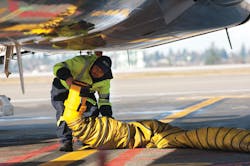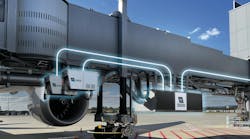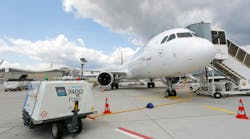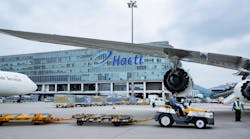Last month, we reported that the Seattle-Tacoma International Airport had turned on a different sort of air conditioner (and heater, for that matter) to aircraft parked at its 73 gates.
The airport had built a centralized plant to deliver preconditioned air through 15 miles of pipes to each of the airport’s gates. The $43 million improvement was paid, in part by one of the largest VALE grants of its kind.
The new PCA system provides both environmental and financial benefits in keeping with the airport authority’s Century Agenda goal to reduce the airport’s energy costs and carbon footprint. With no APUs or diesel GPUs operating, the airport expects the PCA system to cut fuel use by 5 million gallons, saving airlines more than $15 million a year, and cut carbon emissions by 40,000 metric tons.
Startup of the project began at gates on the A and B concourses along with the south satellite. The remaining concourses and north satellite are expected to come on line by the end of 2013.
Piping installed within the existing terminal connects all of the gates to a system of chillers and heaters to provide the PCA. The central plant, located below the terminal’s food court, houses four 750-ton chillers that fill 16 ice storage tanks with ethylene-glycol solution cooled by electricity furnished by the airport. Four secondary pumps circulate the chilled liquid through pipes to the gates for cooling.
Alternately, the airport’s steam plant heats water that is piped to gates for heating. A heat exchanger at the gate directs the conditioned air through a telescoping duct on the jet bridges, to a ventilation hose and directly into the aircraft’s cabin.
What’s more, Sea-Tac gets about 90 percent of its power from hydro-electric dams and 10 percent from renewable energy and nuclear sources, meaning the power used to generate PCA is that much greener.
Ironically, Sea-Tac’s boomerang-shaped terminal, built when the airport still used an X-shaped runway grid, created a big advantage by allowing a relatively short distance to installing the network of piping to the gates.
MORE INFO NEEDED
All good and well, but after sharing the news with our 930-some members of our Ground Support Worldwide LinkedIn group, the GSE professionals wanted to know more.
Gabriel Serrano, Aeroservicios USA Inc., got the discussion going when he asked how the airport controlled the flow and temperate on different sized aircraft.
We sent the question on to Perry Cooper, the airport’s media and public affairs manager.
“At the ramp level, connected to the jet bridge is a control for the hose hook-ups,” Cooper wrote back. “There are three settings: Wide Body, Narrow Body and Regional. The ramp handler selects which is appropriate for the aircraft at hand. For larger aircraft there are two hoses that can be hooked up (757, 767,747, 777, 787, A330, A340). Each gate is set up for the type of aircraft that could be at that gate. The hot and cold going into each of the air handlers at the gate are constant. The aircraft will then meter how much heating and cooling it needs.”
A helpful explanation, no doubt. But Roderick Oates, a deicing specialist from the UK, wanted more information.
“This is a very interesting concept,” he posted. “You say the aircraft monitors the quantity of atmospheric conditioning given by the terminal. Surely this requires a connection between the aircraft and the terminal? Why is it that the air bridge itself does not include the aircraft in its own air conditioning?”
Mark Frink, sales engineer for Hobart Ground Power, chimed in with what he knew.
“One small correction to Perry Cooper's information,” he wrote. “According to Boeing's MFEPD the 757 and 767 aircraft only have one PCA hose connection.
“The aircraft has no control over the PCA it receives from either a point-of-use PCA unit or a facility PCA system. Usually, a temperature probe is placed in the open doorway of the aircraft. The probe provides a feedback signal to the POU PCA unit or the building PCA unit (which would have a damper to control the cold air flow and a heater to warm the air up in the winter).
“The advantage of a properly installed underground system is that there is very little variability in the temperature of the air presented to the air handler at the end of the bridge. Where an above ground air system has to contend with the variability’s of the ambient temperatures in the hose path.
“The disadvantage is the huge upfront cost of building the chiller plant and putting all of the tunnels in place. There is also the single-point of failure problem that if the chiller plant has a failure, all of your gates lose their PCA capability.”
Oates replied: “This is a first-class explanation of the entire process. Many thanks, Mark.
That the airport’s handling agents are required to maintain a fleet of air-conditioning equipment and. in temperate climates. a fleet of heaters is a little worrying. These would in my experience be neglected until such time as the system failed and the equipment would be dragged out of some poorly maintained area and expected to perform. I think we all realize the quickest way to damage a machine is to neglect it – flat batteries poor fuel, frozen fuel, flat tires. The chance of a response being measured in anything beyond days is remote. Of course, the solution would be to have two systems. This would bring into question the entire funding philosophy of airports.”
Later, Oates added what can only be deemed the dark side of green: “The aircraft must be known to be about to dock at a certain stand. Why then doesn't the information of aircraft type arrive along with the departure information? This would again reduce the numbers on the ground. Given pier power is a permanent fixture on many major airports, the only people required would be those who load the hold, those who fill the catering requirements and those who remove the toilet material and replenish the water. Given towbarless tugs and the entire operation could be done with a small number of people.”
Membership in our LinkedIn group has easily tripled in the past 12 months. We routinely post news from not just the magazine, but news around the world about the GSE industry.
If you’re not member, log on to www.LinkedIn.com and enter “Ground Support Worldwide” in the search box. We'll provide a direct link to the group when we post this article to www.aviationpros.com.





